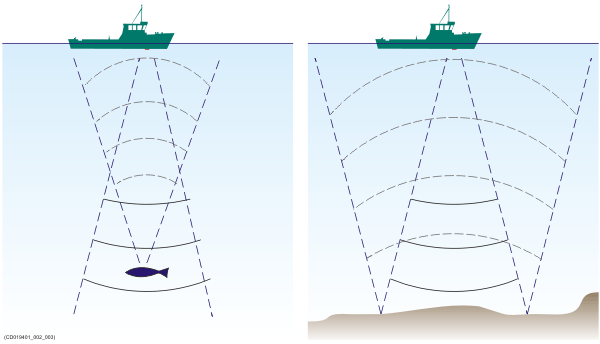About sound wave propagation
The velocity of sound wave propagation in the sea varies slightly with temperature, salinity and pressure.
The velocity varies between 1440 and 1520 m/s in shallow sea water, while a velocity around 1480 m/s can be expected at 1000
m depth. In shallow fresh water the velocity is approximately 1430 m/s. Unless you have a relevant sensor available, a good average sound speed value is 1470 m/s.
The EK80 transmits high energy sound wave pulses into the sea. A flat bottom reflects the transmitted wave as if it was a mirror. The propagating energy is spread over a larger and larger area as it travels down to the bottom and up again. The energy is spread over a four times larger area every time the travel distance doubles.

A large school of fish reflects sound waves similarly. This type of spreading is referred to as square-law or 20 log TVG (Time Variable Gain) spreading. In the Echogram dialog box 20 log TVG spreading is referred to as School Gain and Bottom Gain, while 40 log TVG spreading is referred to as Fish Gain.
The situation is slightly different when observing the echoes from individual fish.
The transmitted wave undergoes square-law spreading when travelling from the surface and down to the fish. The swim bladder
of the fish scatters a small fraction of the arriving energy in all directions. Travelling from the fish and back towards
the surface the scattered wave undergoes another square-law spreading.
The combined effect is referred to as quad-law or 40 log TVG (Time Varying Gain).
Propagation losses due to absorption are much higher in sea water than in fresh water. Absorption also increases with frequency.
At 38 kHz the absorption is 0.5 dB/km in fresh water and 10 dB/km in sea water. At 200 kHz the absorption is 10 dB/km in fresh
water and 50 dB/km in salt water. The EK80 must know which water type is present in order to compensate for these losses correctly.
The dB (decibel) unit has long traditions in underwater acoustics and other fields in physics. It is a logarithmic measure for the ratio between two quantities.